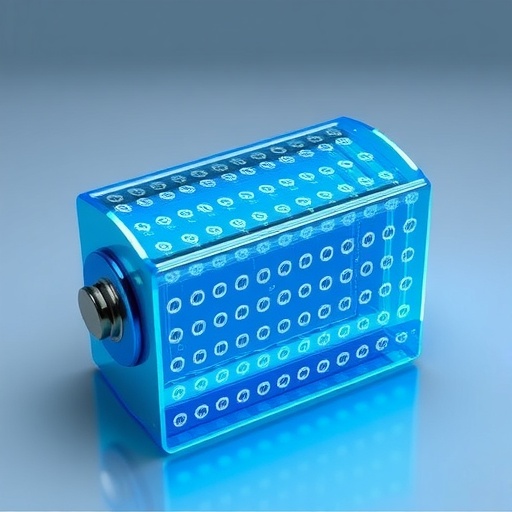As electric vehicles (EVs) gain traction in the global market, understanding the intricacies of the materials that power these vehicles becomes increasingly crucial. A recent study led by researcher J. Meng delves into the effect of temperature on the charge-discharge cycle performance of lithium-iron phosphate (LiFePO4) batteries, highlighting their significance in the EV landscape. The findings are not just academic; they cast light on practical implications that could shape the future of electric mobility.
The rise of electric vehicles has been accompanied by a corresponding increase in the demand for efficient energy storage solutions. Among various battery technologies, lithium-iron phosphate has secured a prominent position owing to its thermal stability, safety characteristics, and long cycle life. However, one area that has often been overlooked is the impact of temperature fluctuations on these battery systems. Understanding how temperature influences battery performance is essential, given that EVs operate in diverse climatic conditions worldwide.
One of the core tenets of Meng’s research is the emphasis on charge-discharge cycles, a critical measure of battery performance that directly correlates with vehicle range and longevity. Performance metrics in this area typically include capacity retention and energy efficiency. By systematically studying the relationship between temperature and these performance indicators, Meng provides valuable insights that could inform battery management systems in EVs.
LiFePO4 batteries operate optimally within a specific temperature range, and deviations from this range can lead to diminished performance. For instance, if the temperature exceeds optimal levels, it can accelerate electrolyte degradation and reduce the battery’s lifespan. Conversely, low temperatures can impair lithium-ion mobility, thereby affecting charge and discharge efficiency. Understanding these dynamics can help manufacturers engineer better battery designs that can withstand a variety of environmental conditions.
Meng’s study presents data that elucidate the nuances of temperature-induced performance variations. For example, the researcher observed that at elevated temperatures, the charge and discharge rates increased, but this came at the cost of accelerated degradation over time. Conversely, lower temperatures resulted in decreased efficiency but increased the overall lifespan of the battery. The balance between these competing factors is delicate and underscores the need for innovative thermal management solutions.
Temperature impacts not only the immediate performance but also the safety profiles of LiFePO4 batteries. As the demand for electric vehicles grows, so too does the imperative to ensure that these batteries can operate safely in varying temperature scenarios. Overheating can pose risks, including thermal runaway, while extremely low temperatures can lead to battery failure. Understanding these risks will allow manufacturers to create batteries that meet stringent safety standards while still providing optimal performance.
Another significant finding in Meng’s research is related to the charge retention capabilities of LiFePO4 batteries under different temperature conditions. Charges can dissipate more quickly at high temperatures due to increased reaction rates, while cold conditions can create lithium plating on the anode. These findings could inform better charging protocols for EV users, such as recommendations for charging speeds based on environmental temperatures.
In addition to performance and safety, the research touches on the economic implications of temperature effects on battery life and maintenance costs. Enhanced understanding of temperature dynamics can lead to better lifecycle predictions and lower operational costs for electric vehicles. This is crucial as price remains one of the main barriers to EV adoption; improved longevity and reduced maintenance translates to increased consumer acceptance.
Meng’s work not only provides empirical data but also sets the stage for further research into advanced materials. For instance, exploring additives or coatings that can improve performance at extreme temperatures could be a promising line of inquiry. Similarly, future studies may investigate how combining LiFePO4 with other battery chemistries could mitigate temperature-related issues, thus achieving a more versatile and powerful energy storage solution.
Collaboration between researchers and manufacturers is key to translating these findings into practical applications. As the EV landscape evolves, partnerships that leverage academic insights with industry pragmatism will be vital. This synergy can lead to the development of more robust battery systems capable of meeting the demands of modern consumers while adhering to modern safety and environmental standards.
In conclusion, J. Meng’s study on the effects of temperature on the charge-discharge performance of lithium-iron phosphate batteries is a critical step forward in battery technology for electric vehicles. As we look towards a future powered by sustainable energy, research like this is essential in guiding both battery innovation and the broader electrification of the transportation ecosystem. The implications are vast, affecting not just manufacturers and consumers but also influencing policy decisions and infrastructure development worldwide, paving the way for a greener, more efficient future for electric mobility.
Subject of Research: Temperature Effects on Lithium-Iron Phosphate Batteries
Article Title: Effect of temperature on the charge-discharge cycle performance of lithium-iron phosphate batteries for electric vehicles.
Article References:
Meng, J. Effect of temperature on the charge-discharge cycle performance of lithium-iron phosphate batteries for electric vehicles.Ionics (2025). https://doi.org/10.1007/s11581-025-06760-w
Image Credits: AI Generated
DOI: https://doi.org/10.1007/s11581-025-06760-w
Keywords: Lithium-iron phosphate, battery performance, charge-discharge cycle, electric vehicles, thermal management.
Tags: battery performance metrics for EVscapacity retention in lithium batteriescharge-discharge cycle efficiencyclimate effects on battery performanceelectric vehicle battery technologyenergy efficiency in charge-discharge cyclesenergy storage solutions for EVsimplications for electric mobilitylithium-iron phosphate battery performancetemperature fluctuations in electric vehiclestemperature impact on lithium-iron phosphate batteriesthermal stability of LiFePO4 batteries





